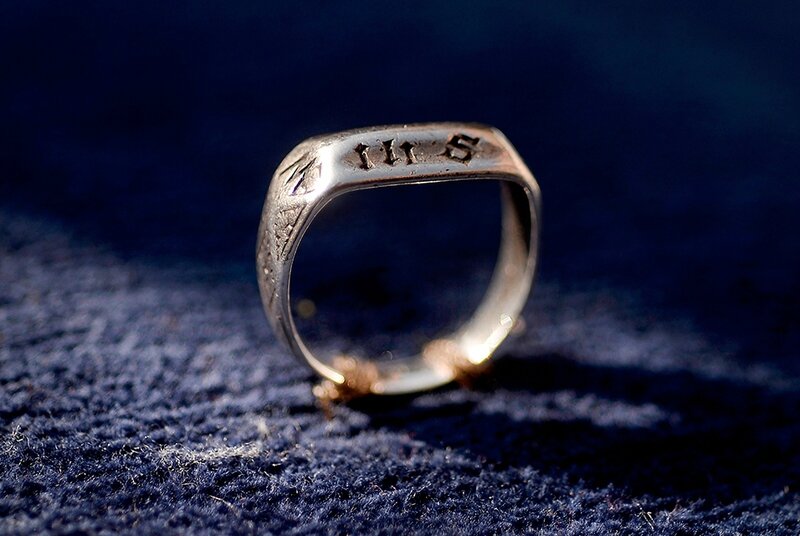Has France finally reclaimed famous historical martyr Joan of Arc's ring?
A 15th century ring believed to have been owned by the French heroine Joan of Arc is seen on a cushion during a ceremony on March 20, 2016 at the Puy du Fou historical theme park in Les Epesses, western France. The Puy du Fou foundation announced in early March 2016 to have bought the ring attributed to Joan of Arc and valued at 376,883 euros in Great Britain, but whose "authenticity could not be certified" by the L'Historial Jeanne d'Arc museum in Rouen. JEAN-SEBASTIEN EVRARD / AFP.
ROUEN (AFP).- A ring thought to belong to France's most famous historical martyr, Joan of Arc, was unveiled on Sunday at a theme park, even as historians remained sceptical about its authenticity.
The Puy du Fou historical theme park in the western Vendee region spent 376,833 euros ($425,000) to buy the ring, which is thought to have been in Britain for almost six centuries, at a controversial auction last month in London.
The gold-plated silver ring was dated to the 15th century by an Oxford laboratory, but the trove of historical documents that came with it have yet to prove it belonged to the famous French martyr.
"They are only at the start of the exploration. It's a lot of work but a beautiful adventure," said expert Vanessa Soupault, who observed the ring recently and confirmed traces of gold were visible under the surface.
The bulky piece of jewellery features three engraved crosses and the inscription "JHS-MAR", signifying "Jesus-Maria".
That fits a description recorded at Joan of Arc's trial in 1431, where she told the court the ring had been given by her parents.
Puy du Fou says the ring was probably enlarged and modified at some point in the last 200 years.
Joan of Arc, who fought against the English occupation of France during the Hundred Years War, was burned alive at the stake but became a symbol of French resistance and was later made a saint by the Catholic Church.
Not the first time
The difficulty of tracing the ring's path through the centuries has left many historians sceptical.
It was thought to have been confiscated by her Burgundian captors shortly before they handed her over to the English, and may have ended up in the hands of the archbishop of Winchester, Henry Beaufort, who was present at her trial, and stayed in Britain ever since.
But it is not the first time the ring has supposedly returned to France, said Olivier Bouzy, head of the Joan of Arc archives in Orleans.
In the 1950s, a French-English doctor called James Hasson said he had bought the ring and presented it around France. Experts at the time cast doubt on its authenticity, said Bouzy.
Part of the problem is the number of copies in circulation. There was even a tombola in the early 20th century in which prizes included versions of the ring.
"Around Joan of Arc, we already have several cases of false objects," said Bouzy.
One of the more famous was when a fragment of an Egyptian mummy was mistaken for one of Joan of Arc's ribs, recovered from the stake.
The Museum to Joan of Arc in Rouen chose not to participate in last month's auction, fearing another fake.
But medieval historian Philippe Contamine, while not yet convinced, said he had not given up all hope.
"It's unlikely -- there are too many unknowns," he said.
"But unlikely can still turn out to be real.". © 1994-2016 Agence France-Presse

/https%3A%2F%2Fprofilepics.canalblog.com%2Fprofilepics%2F1%2F0%2F100183.jpg)
/https%3A%2F%2Fstorage.canalblog.com%2F03%2F02%2F119589%2F96711876_o.jpg)
/https%3A%2F%2Fstorage.canalblog.com%2F11%2F31%2F119589%2F94773502_o.jpg)
/https%3A%2F%2Fstorage.canalblog.com%2F20%2F83%2F119589%2F94772815_o.jpg)
/https%3A%2F%2Fstorage.canalblog.com%2F26%2F72%2F119589%2F75604929_o.jpg)
/https%3A%2F%2Fstorage.canalblog.com%2F59%2F60%2F119589%2F26458628_o.jpg)




/http%3A%2F%2Fstorage.canalblog.com%2F76%2F15%2F119589%2F129393400_o.jpg)
/http%3A%2F%2Fstorage.canalblog.com%2F70%2F68%2F119589%2F129131712_o.jpg)
/http%3A%2F%2Fstorage.canalblog.com%2F13%2F69%2F119589%2F129078661_o.jpg)
/http%3A%2F%2Fstorage.canalblog.com%2F93%2F01%2F119589%2F129030904_o.jpg)